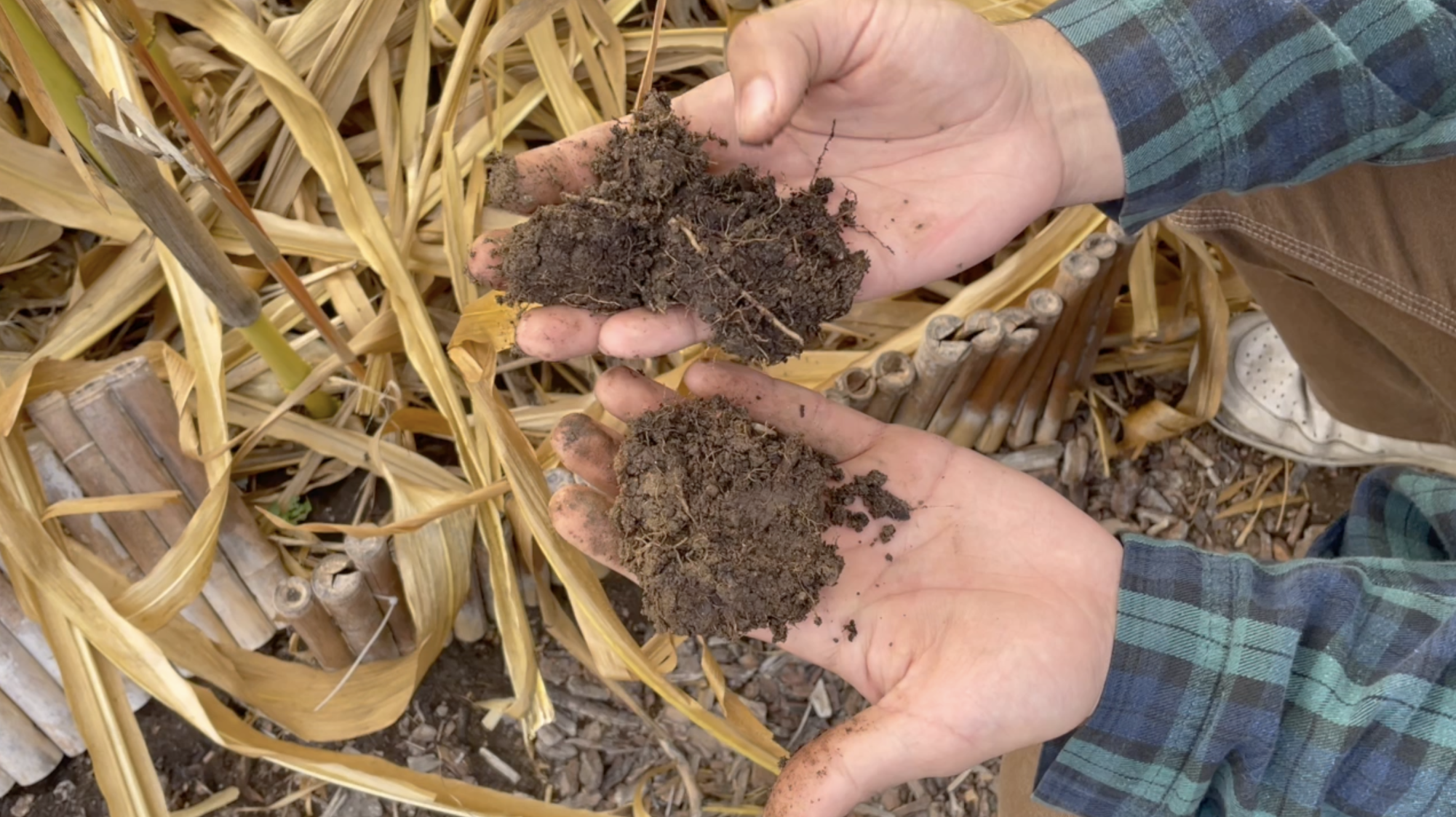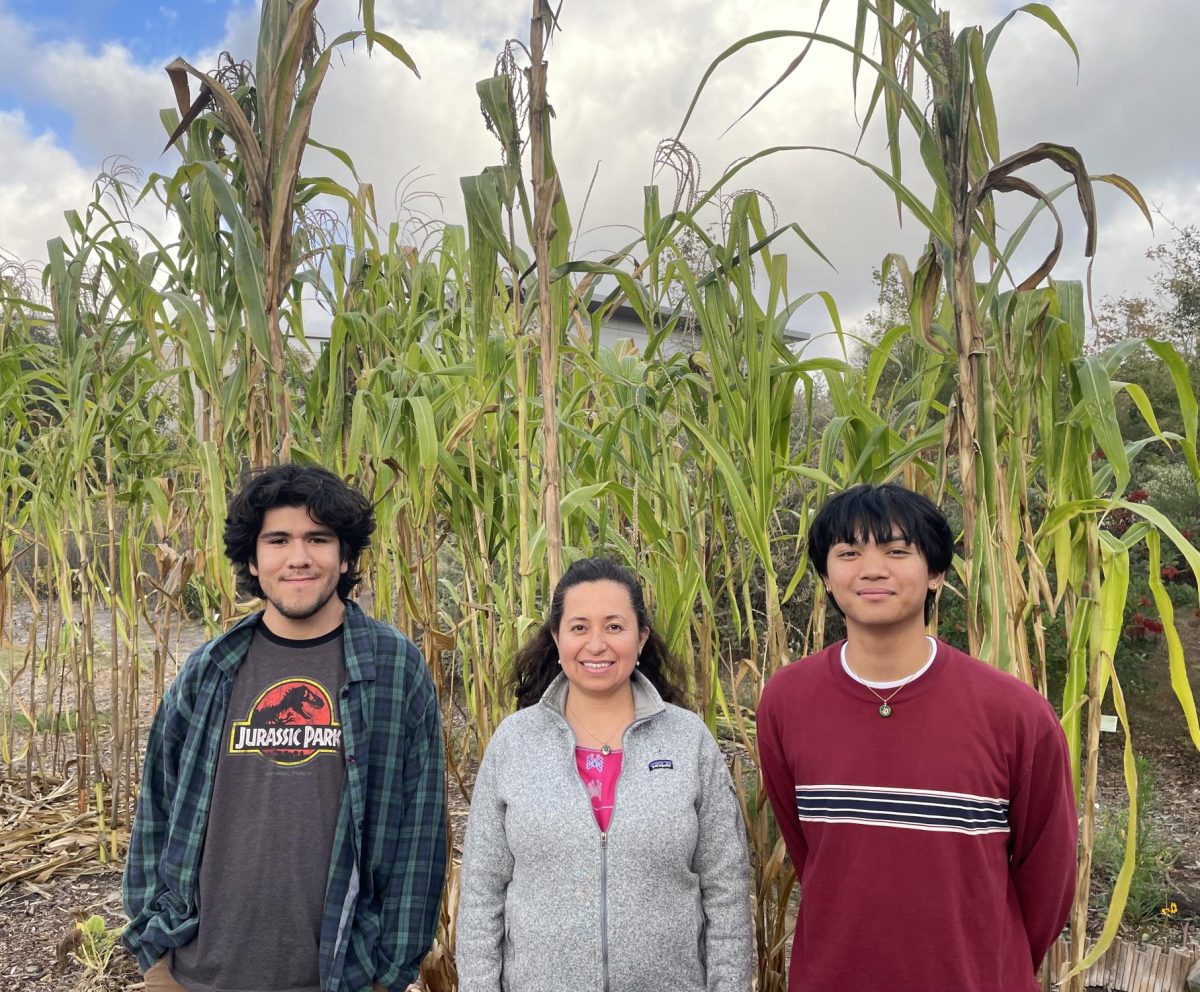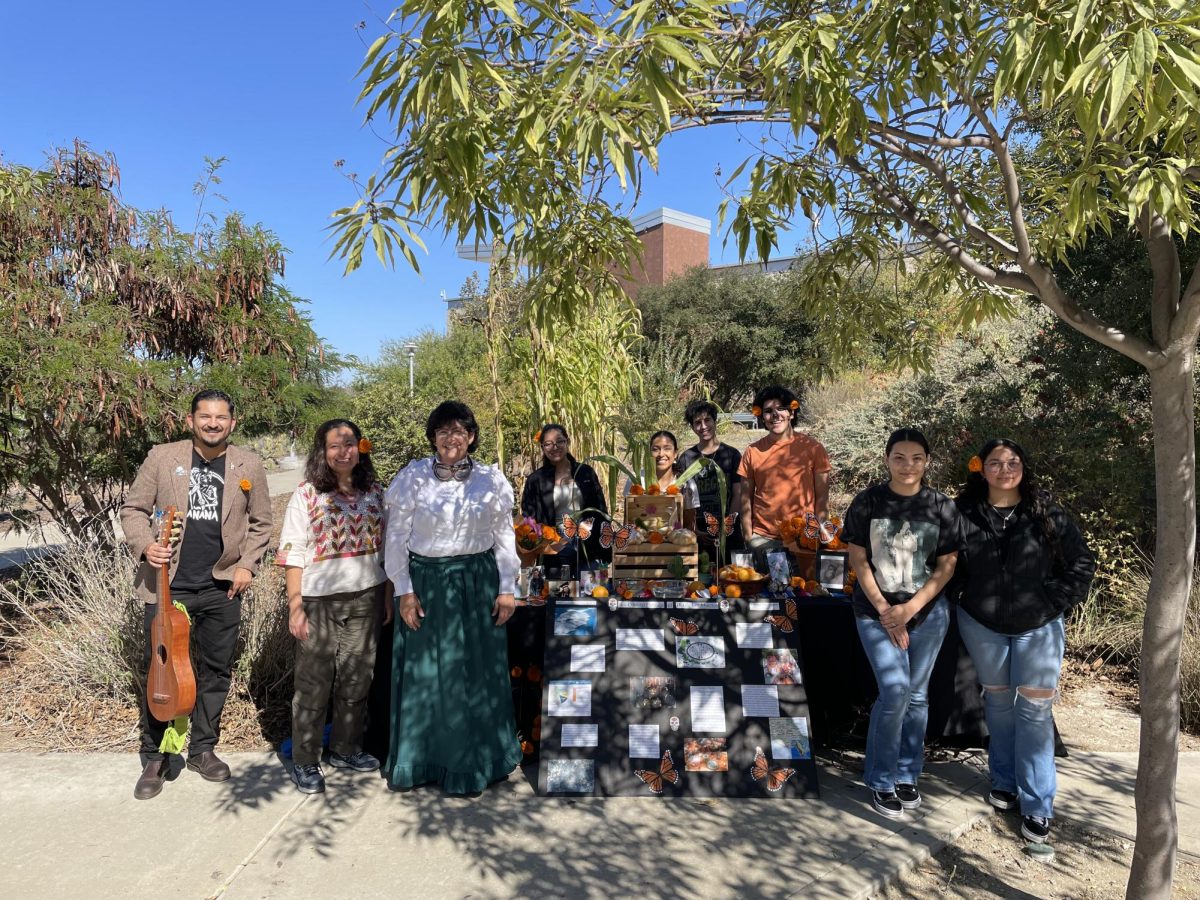Since it broke ground last May, the milpa has created a surprising amount of attention through word of mouth alone.
Dr. Erika Diaz-Almeyda, who directs the project, conceived of the milpa with Ethnic Studies professor Dr. Garzo-Montalvo. “Wouldn’t this be like the perfect place to do a milpa,” she asked him.
In record time they got something on the ground, and it is showing strong signs of success. “I cannot believe that now it is done. With all the challenges, we did it. We went from nothing to something in like a year,” Dr. Diaz-Almeyda said.
According to Dr. Garzo-Montalvo, milpas are an Indigenous Mesoamerican form of companion planting traditionally of corn, beans, and squash – also known as the “Three Sisters.” Additionally, milpas can include medicinal plants, flowers that attract pollinators, and other edibles.
Milpa translates to “corn field.” Although derived from the Indigenous language of Nahuatl, this practice connects across the Americas under various names. Where Dr. Garzo-Montalvo’s family is from in South America, milpas are called “chakras.”
“Corn provides another way to map our relationships here, up and down, across settler borders. The ways in which our pueblos – our communities, our peoples – all the way from where my family is from in South America, all the way to Alaska native relatives… we have exchanged corn up and down since time immemorial,” Dr. Garzo-Montalvo said.
Alexis Rios, a third-year biology student leading Dr. Diaz-Almeyda’s project, comes from a family background of farm workers. He works on the milpa at least once a week but spends every day researching, reading books and academic articles.
Although he is passionate about his biology research, the milpa means more than that. “I hold the milpa very dear to my heart,” he said.
“Hearing the leaves blowing is like therapy for me. It connects me to my ancestors and my culture. Humans have evolved with corn for thousands of years, and the milpa is a teacher for us. This is something close to home for me. It is the place I go to when I feel homesick,” he said.
Dr. Garzo-Montalvo says milpas are a “connection to our ancestors, our ancestral knowledge systems, and our Indigenous science paradigms – our forms of Indigenous science that show how agriculture, polyculture, our relationship with food and with plant medicine is a way for us to practice science, arts, and spirituality all at once. These are things that are not separated in our traditional worldviews – things that are otherwise separated into disciplines in the Western mind.”
Many individuals involved with the milpa speak of this Indigenous farming practice as a form of “cultural resistance.” In her essay, “Milpa: Mesoamerican Resistance to Agricultural Imperialism,” Analisa Taylor describes milpas as such.
Approximately eight thousand or more years ago, the Indigenous peoples of Southern Mexico began domesticating maize. This “corn-human bond” is central to Mesoamerican culture. Yet now this sacred and symbiotic relationship between Mesoamericans and corn is threatened.
Mexico’s corn is increasingly imported from the United States due to its highly subsidized agricultural industry. Worsened by free trade agreements, Mexico’s disadvantage negatively affects domestic corn production.
More importantly, milpas are unable to thrive in a global economy that prioritizes profit. Such a diverse and sustainable polycrop farming practice cannot compete with the U.S. production model, based on land and labor exploitation.
Empowering milpa farming practices is an essential aspect of Mesoamerican movements that demand sovereignty, self-determination, and environmental preservation.
“Just a week or two ago an Indigenous leader in Mexico was killed. So this is so important. What I see is, at least in the US we have the freedom to do some of these things without getting killed,” Dr. Diaz-Almeyda said.
Corn produced in the US is “uniformly ultra-hybridized, uniformly yellow, and much of it genetically modified,” Taylor writes. For many Mesoamericans, this is a tremendous blow to their cultural sovereignty and traditional foodways.
As a result, the research focus of the milpa is on soil microbiology, a relatively unexplored topic for milpas. Understanding the microbial ecology of the milpas is going to help preserve Mesoamerican culture and develop sustainable climate crisis solutions.

The research has proved successful and already turned many heads. But for those involved, the milpa has more potential.
The milpa is currently located in the Community Ethnobotany Garden. Founded in 2007 by the anthropology department and directed by Dr. Bonnie Bade, the Community Ethnobotany Garden is a unique space for both research and community-building. With the support of Dr. Bade, the Innovation Hub, and the biology department, the milpa has prospered.
Nevertheless, the milpa is pushing for additional resources and support on campus. Water accessibility has been a big issue, requiring volunteers to haul gallons of water from their lab to the milpa. Space is another problem, as many folks would like to see the milpa become a more integrated and educational fixture on campus.
Already the milpa has served as a multifunctional space for community members. Professors across disciplines have taught classes at the milpa and students from diverse backgrounds have responded enthusiastically.
According to Dr. Diaz-Almeyda, “Some come to the milpa with first or second-hand knowledge from their families or communities. The milpa is a space for a dialogue that shares and creates knowledge for all people. For those who know nothing about the milpa, this experience offers an alternative farming practice.”
“Even though the milpa is a Mesoamerican thing, it is very welcoming because everyone eats,” she laughs.
This experience is not exclusive to students and faculty. Obdulia, a groundskeeper at CSUSM, regularly has lunch at the milpa. She grew up around milpas and is a knowledge keeper for the students and faculty. “It gives her a space not just to come and enjoy, but also to show that her contributions and her teaching are valued,” Dr. Diaz-Almeyda said.
Students shared a wide range of positive feelings. A common experience is that students feel empowered to explore and embrace their ancestral roots.
Alexis would like to see the milpa promoted as an alternative form of therapy for Latin students, potentially in collaboration with CSUSM Student Health & Counseling Services (SHCS). He knows first-generation students who feel pressure to assimilate and wants the milpa to support them.
Beyond serving Latin students, Alexis hopes the milpa can set an example for additional polycrop farming practices at CSUSM. More specifically, embracing agricultural resistance for other communities.
Joshua Liberato, a Filipino student and volunteer in the space, says the milpa made him question his roots, including what Filipino farmers may be doing and how he can support those practices too.
“The Philippines exports most of its rice and the people do not get to consume their own. The rice they eat is imported. For me, the corn stalk [in the milpa] is like therapy. Working in this area of the suburbs, it is healing to have corn, beans, and squash. It puts community first and focuses on life, not profit. I want to bring what I’ve learned back to my community,” he said.
CSUSM History professor, Alan Malfavon, says that our campus “is still lagging behind in ways to properly incorporate the ancestral, cultural, and social traditions of the majority Chicanx and Latinx student population on campus as a defining part of our campus and its identity. The Milpa is a way to ground the historical and cultural experiences of our students and their families, creating community, connection, culture, and inviting students and the greater community at CSUSM to explore Mexican and Latin American History and culture.”
He believes that “Milpa stands on campus as a symbol of cultural, social, and historical resistance to many far-right factors that unfortunately surround Latinx students in North County.”
“When we lose track of our history, our culture, our roots, and where we and our families and ancestors come from, we are adrift in a sea of misinformation and division. Embracing the history and culture of our communities, in this case through the Milpa project, connects all of us with a millenary tradition of agriculture… The Milpa is culture, resistance, thriving, and solidarity. And I hope to see more students, faculty, and administrators support the project as part of greater efforts to bring more visibility and roles for the Latinx student, faculty, and staff community at CSUSM,” Dr. Malfavon wrote.
Dr. Diaz-Almeyda sees potential for the milpa to have long-term support, increased accessibility, and community education opportunities at CSUSM. “I want it to be demonstrative. Something people can walk by, use the space, and see how it works,” she said.
Alexis still has at least a couple years before graduation and is potentially looking at graduate school, researching milpas.
On Dia de Los Muertos, students, staff, and faculty gathered at the milpa to celebrate the occasion and their accomplishments. The overwhelming feeling is that, even with their many achievements, the milpa is just getting started.
“It’s going to explode,” Dr. Diaz-Almeyda said. “It’s just waiting to blow up. This is going to take over.”




